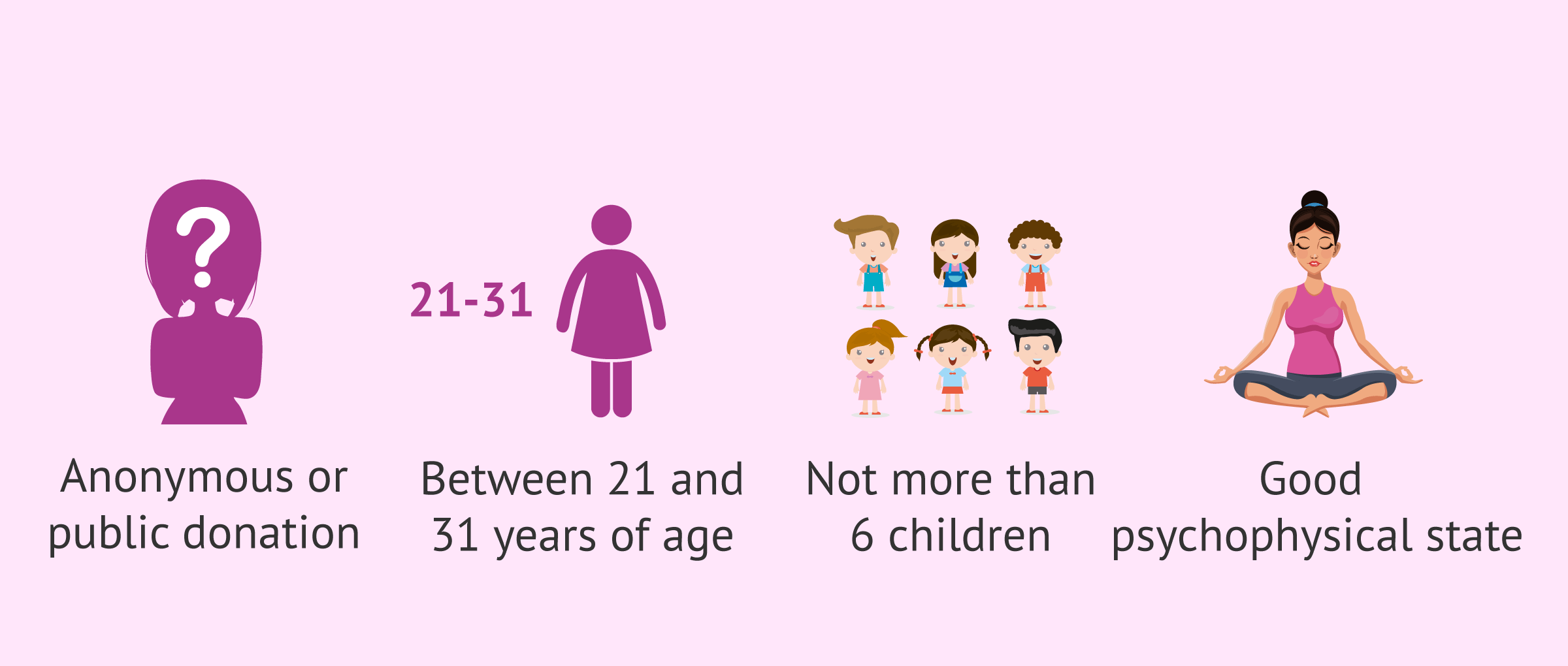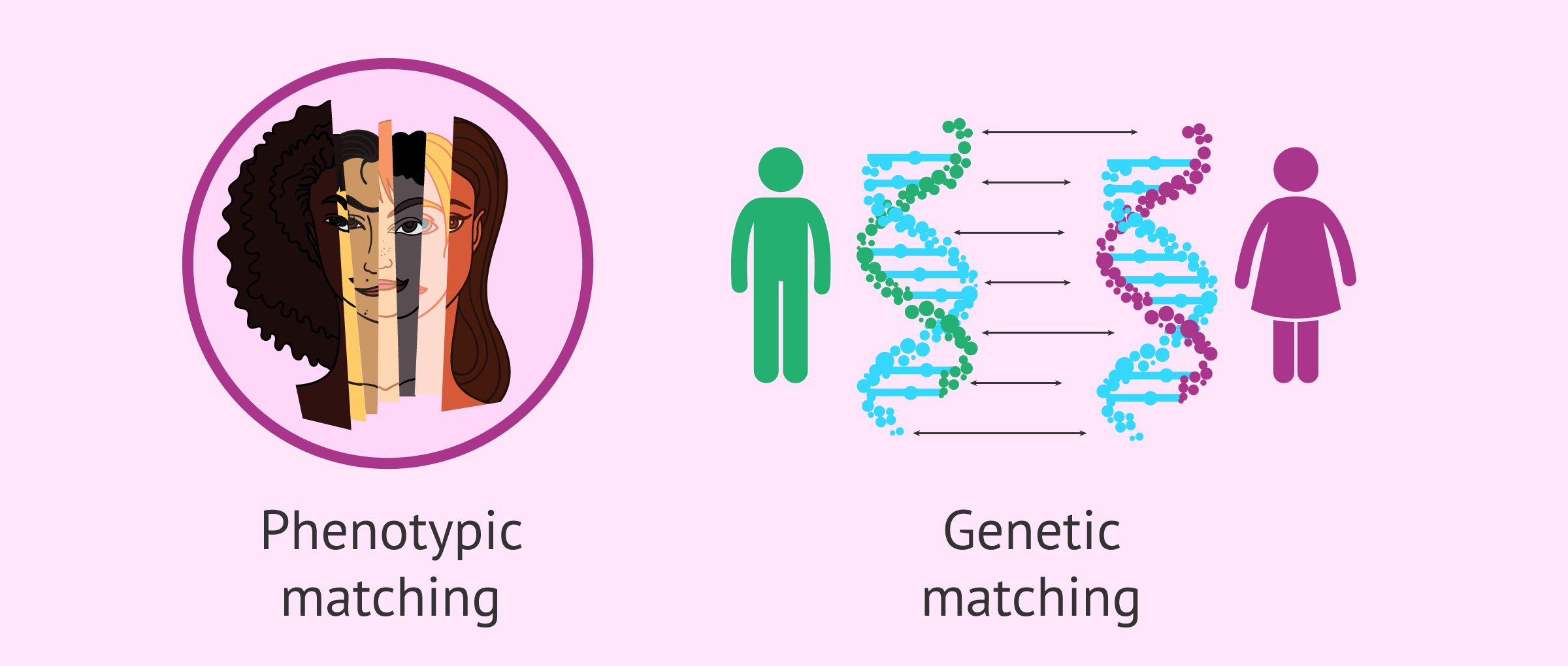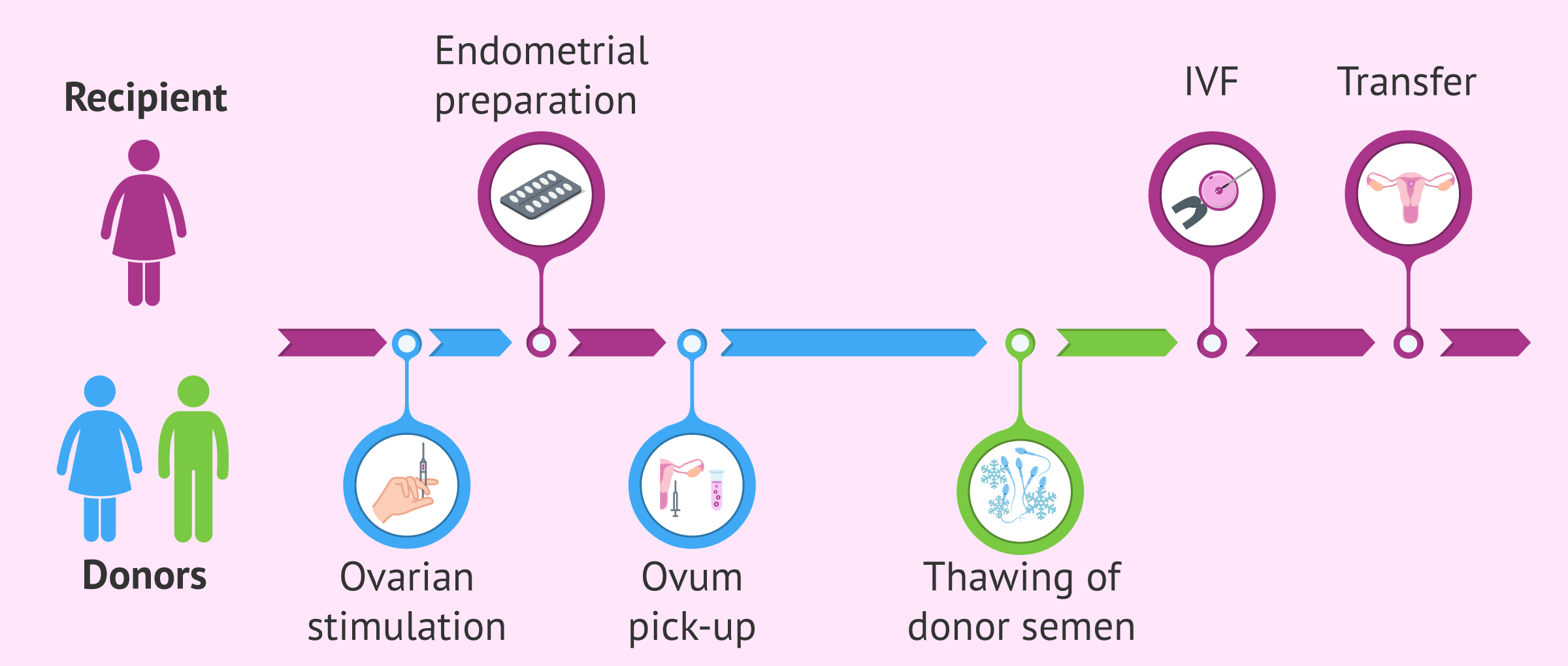In vitro fertilisation (IVF) with double gamete donation consists of a fertility treatment in which the sperm of a donor is used to fertilize the eggs of a donor, both of which are anonymous, and transfer the resulting embryos to a woman or a recipient couple.
IVF with egg and sperm donation is used in cases where patients are unable to contribute their own gametes due to various fertility problems.
Although it is an expensive treatment, IVF with double donation is a completely safe technique with very high success rates, allowing pregnancy to be achieved in most cases.
Provided below is an index with the 10 points we are going to expand on in this article.
- 1.
- 2.
- 3.
- 3.1.
- 3.2.
- 3.3.
- 3.4.
- 4.
- 5.
- 6.
- 7.
- 7.1.
- 7.2.
- 7.3.
- 7.4.
- 7.5.
- 8.
- 9.
- 10.
What is double-donor IVF?
IVF with eggs and donor sperm is a fertility treatment in which both members of the couple give up the genetic load of their gametes and turn to those of donors in order to become parents.
Gamete donation is a legal practice in the U.S and is characterized by the following points:
- Gamete donation can be either anonymous or open.
- Donors must be in good physical and mental health, between 21 and in case of women, under 31 years old.
- Donors must pass a series of medical and psychological tests.
- No more than 6 children born from the same donor.
- The clinic is in charge of selecting donors based on the physical and immunological characteristics of the recipients. The egg donors can be chosen by the woman, couple or the clinic staff.
- Donors will receive financial compensation which depend on the number of eggs produced and the qualifications of the egg donor, among other things.
If you want more detailed information about this, you can read on here: Assisted Reproduction with donor eggs and sperm.
Indications
Double donor IVF is used in severe cases of infertility, when neither the woman nor the man are able to achieve a pregnancy with their eggs and sperm.
We will now discuss the main causes of this male and female sterility:
- Couples with sterility problems
- Missing ovaries, ovarian failure, low ovarian reserve, secretory azoospermia, repeated IVF failures with own gametes, risk of transmission of a hereditary disease from both parents, etc.
- Single Mothers
- in addition to needing donor sperm, these women also require egg donation due to advanced maternal age, poor egg quality, lack of eggs or other causes of female sterility.
- Gay women
- as in the previous case, a couple of women will have to resort to egg and sperm donation if neither of them can provide their own eggs.
In any case, the specialist doctor will always recommend to the woman or couple which is the best option to achieve pregnancy based on their specific situation.
The treatment step by step
The process and techniques for performing in vitro fertilization are the same as in the conventional form, but in the case of IVF with double donation two more figures are involved: egg and sperm donors.
Below, we will detail step by step the entire IVF procedure for both donors and recipients.
Donor selection
Donors are young, completely healthy men and women who anonymously and unselfishly give their sperm and eggs to be used by a woman or couple with fertility problems.
As we have said, these donors have to go through different medical and psychological tests before being considered suitable for donation, such as the following:
- In men
- physical examination, karyotype, seminogram, blood test, microbiological culture and psychological interview.
- In women
- physical examination, karyotype, ultrasound, blood test, microbiological culture and psychological interview.
Furthermore, the clinic will try to ensure that donors have similar physical characteristics to recipients: hair and eye color, height, etc. and make a good phenotypical match.
Additionally, more and more clinics today include genetic compatibility testing, a test that allows the most compatible donors to be matched, so that they do not share any genetic mutations that could lead to a sick baby. This is what is known as genetic matching.
Process for the egg donor
Once the egg donor has been selected, she will have to take hormonal medication for approximately 2 weeks to perform controlled ovarian stimulation and obtain several mature follicles.
Every two days or so, the egg donor will come to the clinic for a hormonal and ultrasound control of the stimulation.
As soon as the follicles are grown, the gynecologist will proceed to extract the eggs by means of a follicular puncture or ovum pick-up, a very simple operation that is done under sedation.
This is where the process ends for the egg donor. She receives the financial compensation and, if indicated by the doctor, she will have to return for a final check-up.
Egg donation can be done either fresh or with frozen eggs from a donor bank. In the first case, it would be necessary to synchronize the donor's menstrual cycle with the recipient's and contraceptive pills would be used first.
You can read more about this in the following article: Egg donation: requirements, procedure and compensation.
Treatment in the recipient
The recipient of the eggs, has to follow an endometrial preparation treatment so that the uterus is receptive when receiving the embryos. In this way, the embryos will be able to implant themselves in the endometrium and start pregnancy.
To do this, the recipient woman will be given hormonal medication with estrogen and progesterone and will also have to make an appointment at gynecologist's for ultrasound controls of the endometrial growth.
You can find this entire process and a series of recommendations in the following article: Preparing the endometrium for embryo transfer.
Fertilization and embryo transfer
The donor eggs to be used, whether from an egg bank or fresh, are assessed in the laboratory and those that are mature are fertilized with the sperm from the sperm donor.
Donated sperm always come from a sperm bank, as the sample must remain frozen for a while before it can be used. Donor sperm cannot be used fresh as in the case of donated eggs.
Before fertilization, the donor sperm must be thawed and it must be checked that the sperm move and are alive.
The eggs are then fertilized by conventional IVF or intracytoplasmic sperm injection (ICSI) and the embryos are left in culture for a few days.
Once 3 or 5 day old good-quality embryos are obtained and after checking that the endometrium of the recipient is of adequate thickness, the embryo transfer is performed.
The embryos that have not been transferred will be vitrified for any future attempts or to try for further children in the future.
The IVF treatment with double gamete donation will be finished when the pregnancy test is performed after the two-week-wait.
Success rates of pregnancy with donated eggs and sperm
The probability of success of IVF with egg and sperm donation is very high, more so than in an IVF with own gametes. Since the donors are young and in excellent health, this fertility treatment has the highest success rates.
Approximately, the pregnancy rate per embryo transfer is 55-60%, while the delivery rate per transfer is around 40%.
The data provided by the Spanish Fertility Society (Registro Nacional de Actividad 2022-Registro SEF) indicate that the pregnancy rate by fresh embryo transfer obtained from a double donation (eggs and sperm) is 53.2%, while the delivery rate by fresh transfer stands at 40.2%.
In the case of frozen embryos, the data recorded are 44.5% and 32.2%, respectively.
In fact, these percentages are similar to those for egg donation, since the quality of the egg is one of the most important factors determining the success of IVF treatment.
The excellent quality of eggs and sperm guarantees a high rate of fertilization. The embryos obtained are also of very good quality and have a high capacity for implantation.
Notwithstanding, the probability of pregnancy also depends on other factors such as the age of the recipient, uterine receptivity, the characteristics of the uterus and the evolution of the embryos.
Costs
IVF with egg and sperm donation is an expensive treatment, since two donors must be used and all expenses paid, although the price varies greatly depending on the clinic where it is performed.
In general, IVF with double donation of gametes can cost between $14,000 and $20,000.
In addition to these costs, hormonal medication to prepare the endometrium and donor medications are usually not included in the price and can cost an extra $3000-$5000.
If you are interested in reading more about the prices of fertility treatments, we recommend you read the following post: Costs in assisted reproduction.
Donor-egg IVF rises several doubts amongst fertility patients, and clinics often offer misleading or confusing information about egg donation programs. Transparency is, therefore, one of our top criteria when it comes to recommending a clinic to our readership. You can create your Fertility Report now, which will select the best clinic for you out of the list of fertility centers that have passed out rigorous selection process.
Video about IVF with double gamete donation
Michelle Emblenton, biochemist at inviTRA, talks to us in this video about IVF with donor eggs and sperm:
IVF with donor sperm and donor eggs is an assisted reproduction technique in which both the man and the woman give up the idea of passing the genetic load of their gametes onto their children.
FAQs from users
Is there any other alternative to IVF with egg and sperm donation?
Yes, another alternative is embryo adoption. The embryos come from couples who have had viable embryos left over from their IVF treatment and have decided to donate them.
This is an alternative with lower success rates, since the couples who donate them have had to resort to IVF to achieve pregnancy. However, the price is lower and the embryos are always of good quality, otherwise they would not have been accepted for the donation programme.
Does the age of the recipient woman influence the success rates of egg donation cycles?
The age of the recipient woman does influence the success rates of oocyte donation cycles since some studies have detected changes at the uterine level with age that may be responsible for the decrease in embryo implantation rates more markedly after age 45.
Is PGT recommended in IVF treatment with double gamete donation?
Preimplantation genetic testing (PGT) is an advanced tool in the field of assisted reproduction that can be especially considered in in vitro fertilization (IVF) treatments with double gamete donation. Although the use of donor gametes usually implies a lower risk of genetic disorders, given that donors are generally young and have undergone rigorous health screening, PGT can offer additional benefits.
First, PGT allows embryos to be screened for chromosomal abnormalities prior to transfer to the uterus. This is especially relevant, as even gametes from young, healthy donors are not exempt from the risk of genetic abnormalities. Therefore, PGT can increase the chances of successful treatment, ensuring the transfer of genetically healthy embryos.
Second, in cases where patients have particular medical histories or specific concerns, such as genetic diseases in the family, PGT can be tailored to look for these conditions, although the likelihood of occurrence with selected donors is low.
However, it is important to keep in mind that PGT is not a guarantee of pregnancy and does not eliminate all genetic risks. In addition, the process involves additional steps in IVF treatment, including embryo biopsy and, in some cases, may prolong the time to embryo transfer.
In conclusion, the decision to use PGT in double-donor IVF treatments should be individualized and based on a detailed evaluation of the benefits and risks. It is essential that patients discuss their options with their team of assisted reproduction specialists, who will be able to offer specific advice based on their particular circumstances and treatment goals.
How many IVF cycles can be done in double donation?
As with IVF of own gametes, there is no set limit. The woman or couple must decide how many attempts they are willing to make if they do not achieve pregnancy at first.
The success rates of this treatment are high, but if the woman has any problems in the endometrium or uterus, there may be complications for implantation to take place or for the pregnancy to develop properly.
Is it possible to do IVF with both donor eggs and sperm?
Yes, it is. This technique is known as double-donor IVF and is indicated in the following cases: problems in the ovaries (either because of age or other unknown causes), sperm problems (zero or low sperm count, or poor motility), and single females.
For further information, we recommend you to visit the following post: What is double-donor IVF?
Recommended reading
One of the alternatives to IVF with double gamete donation is embryo donation, a more economical treatment that may be available to more patients. If you need information about this, do not hesitate to access the following post: What is embryo adoption?
Want to know about the success rates of the different types of fertility treatments? We recommend you to read on in the following article: Success rates of fertility treatments.
We make a great effort to provide you with the highest quality information.
🙏 Please share this article if you liked it. 💜💜 You help us continue!
References
Ballesteros A, Castilla JA, Nadal J, Ruiz, M. Manifiesto de la SEF sobre la donación de gametos en España. Publicado a través de la Sociedad Española de Fertilidad (SEF).
Colomé C, Carrasco M, Agramunt S, Checa MA, Carreras Collado R. Fertilidad en mujeres mayores de 40 años. Ginecología y Obstetricia Clínica. 2008; 9 (4): 216-227
Comisión Nacional de Reproducción Humana Asistida (CNRHA) (2015). Aspectos legales y éticos de la donación. En: Registro Nacional de Donantes de Gametos y Preembriones. Ministerio de Sanidad, Consumo y Bienestar Social de España. (view)
Kvist U, Björndahl L. ESHRE Monographs: Manual on Basic Semen Analysis. Oxford: Oxford University Press, 2002.
Ley 14/2006, de 26 de mayo, sobre técnicas de reproducción humana asistida. Jefatura del Estado «BOE» núm. 126, de 27 de mayo de 2006 Referencia: BOE-A-2006-9292. (view)
Sociedad Española de la Fertilidad (SEF). Libro Blanco Sociosanitario. La Infertilidad en España Situación Actual y Perspectivas. Imago Concept & Image Development 2011.
Sociedad Española de Fertilidad (SEF) (2011). Manual de Andrología. Coordinador: Mario Brassesco. EdikaMed, S.L. ISBN: 978-84-7877.
Sociedad Española de Fertilidad. Registro Nacional de Actividad 2022-Registro SEF (View)
Sociedad Española de Fertilidad (SEF) (febrero de 2012). “Saber más sobre fertilidad y reproducción asistida”. En colaboración con el Ministerio de Sanidad, Política Social e Igualdad del Gobierno de España y el Plan de Calidad para el Sistema Nacional de Salud.
FAQs from users: 'Is there any other alternative to IVF with egg and sperm donation?', 'Does the age of the recipient woman influence the success rates of egg donation cycles?', 'Is PGT recommended in IVF treatment with double gamete donation?', 'What is IVF with donor eggs and donor sperm?', 'How many IVF cycles can be done in double donation?', 'When is double donor IVF recommended?', 'Is it possible to do IVF with both donor eggs and sperm?', 'How does double donor IVF work, step by step?', 'How much does double donor IVF cost?', 'Are there any alternatives to egg and sperm donation?' and 'Does the woman's age matter in double donor IVF?'.
Authors and contributors


More information about Michelle Lorraine Embleton












Hello, everyone. I’m very hesitant about double donation or embryo adoption. The price of the treatment is a big difference, but of course if with the double donation there are more guarantees it can be worth it. One thing I would like to ask is if anyone knows, in embryo adoption, is there an age limit or can they give you the embryos of a 40-year-old woman? Thank you, if anyone can contribute their experience…
Hi Tati,
As with egg donation, the age limit for a woman to donate her embryos is 35 years. It is also guaranteed that the couple donating the embryos do not have any hereditary disease or risk of congenital malformations.
You can read more about it here: What Is Embryo Donation & Adoption?
Hope this helps,
Best regards